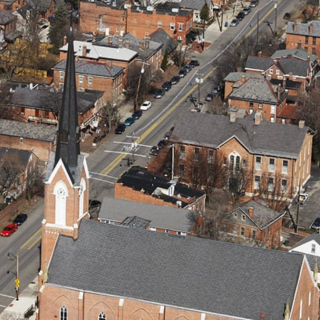Advertisement
I recently stopped by a smoke shop on North High Street to visit a friend. From floor to ceiling, colorful glass pipes – small and large – graced expansive shelves. Several cost more than $1,000. Accessories aimed at every taste aligned well-lit display cases. It was a smorgasbord of everything weed, except for, well, the cannabis. I felt as though I had time traveled and arrived in the future. It wasn’t that long ago (2003) that Tommy Chong spent nine months in prison for selling this kind of glassware. My, how things have changed.
From this perspective, I look back on 2016: how far things have come. Will this contentious year mark the plant’s coming of age or when pendulum of progress swung back the other way?
Any retrospective on marijuana in 2016 must begin with Issue 3 in 2015. This proposed constitutional amendment, fielded as a ballot initiative by “Responsible Ohio,” sought to legalize both the adult and medical uses of marijuana in Ohio under the unusual scheme of 10 cultivation sites run by the measure’s 10 investment groups. Monopoly! screamed the opposition. But an ill-conceived campaign, combined with a hostile Secretary of State and a few flipped votes, caused the measure to fail miserably in the fall general election.
The net result was a frightened legislature and frustrated investors. The legislature despised ceding control to citizens in the ballot issue process. The investors still smelled a profitable market in Ohio. Both looked to do things differently in 2016.
The Ohio House of Representatives kicked off the year by forming the Medical Marijuana Task Force charged with studying the issue. Seven hearings were held at the Statehouse before a 15-member panel that included Reps, business people, medical professionals and two expatriates from Responsible Ohio. Well over 100 people stood before Task Force during February and March and offered testimony.
The Ohio Senate took a different tack. Two Ohio Senators went on a listening tour of the state, holding Town Hall meetings in Cleveland, Toledo and Cincinnati. An audience of 500 or more attended these events, adding to the pool of testimony. By the time the Task Force hearings and Town Hall tours concluded, the Ohio legislature had received a graduate level education in all things cannabis.
Meanwhile, understanding fear as a legislative force, the Marijuana Policy Project (MPP) amped up the heat in February by fielding another constitutional amendment through the initiative process under the moniker “Ohioans for Medical Marijuana” (OMM). The time line was excruciatingly short: collect over 800,000 signatures in just four months to make the fall 2016 ballot. Coordinators were hired, circulators were organized and petitions were printed. The campaign was well on its way toward ballot placement when the unexpected struck: the legislature actually passed a bill.
Nothing lights a legislative fire like the will of the people, particularly where marijuana is concerned. MPP has an impressive track record of challenging and changing cannabis law. If lawmakers didn’t act, the sky would fall – the Ohioans would grow medicinal plants and the elderly would find relief in smoked flowers. So within just four short weeks, lawmakers accomplished what had been impossible for over 20 years: both houses introduced bills, heard testimony and placed a completed law on the governor’s desk by the end of May. The governor signed the measure on June 8th; it went into effect on September 8th. MPP left town and OMM disbanded.
HB 523, as the legislation is known, placed Ohio among the 28 states with medical marijuana laws, although the bill’s provisions are quite restrictive. No growing. No smoking. Just 21 medical conditions. Oversight by the Ohio Medical Board, Pharmacy Board and Department of Commerce.
However, as of this writing, the Pharmacy Board has published 66 pages of proposed rules for dispensaries. The Medical Board and Department of Commerce have done likewise for physicians and cultivators respectively. Among other provisions, these rules allow as much as 25,000 square feet of cannabis to be grown in each of 12 cultivation sites for a fee of $200,000. Forty medical marijuana dispensaries may become operational over the next two years paying an annual fee of $80,000 each. The state is obviously seeing dollar signs.
The icing on the reform cake for 2016 in contrast to 2015 were the eight states and four Ohio cities that passed marijuana ballot initiatives. Adult use became legal in California, Massachusetts, Nevada and Maine. Voters in Arkansas, Florida, Montana and North Dakota enacted medical marijuana laws. The Ohio cities of Bellaire, Logan, Newark and Roseville decriminalized possession.
Cannabis indeed seemed to be coming of age. For someone who toiled twenty years in cannabis reform, the future looked bright.
Not so fast. In one of the most improbable electoral scenarios, Donald Trump co-opted the presidency in November. Irrespective of his other anomalies, his proposed cabinet is stacked with purveyors of prohibition. There’s Senator Jeff Sessions (R-Alabama) for Attorney General who last spring proclaimed, “Good people don’t smoke marijuana.” Representative Tom Price (R-Georgia), the physician tapped to head Health and Human Services, has been called “one of the most consistently anti-marijuana members of Congress.” John Kelly, Trump’s choice for Homeland Security, still sees cannabis as a “gateway drug.” Even though Trump proclaimed support for medical marijuana during the campaign, his fluctuating views cause many to shrug their shoulders and utter, “who knows?”
On the Ohio front, lawmakers still afraid of ballot issues once again moved quickly – just two days before Christmas – to amend a foreclosure bill with a provision to permit the Secretary of State (surprise) and local boards of election to gut citizen-led petitions. Less than two weeks after HB 523’s effective date, Republicans in the House introduced a bill to handcuff state-to-state reciprocity agreements for medical marijuana. More than 100 jurisdictions throughout Ohio have enacted moratoriums on cultivation and dispensaries.
So the question remains. With the passage of legislation and over a dozen citizen initiatives, did 2016 represent a turning point for cannabis, one where it came of age and was embraced by public officials, investors and patients alike, or did the pendulum suddenly swing the other way, back to a time to when a simple glass pipe meant jail time? Stay tuned – 2017 could be a wild ride.



